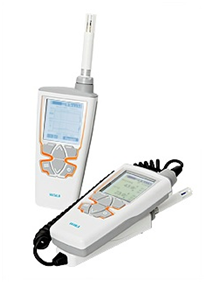Practical Tips for Taking Accurate Humidity Measurements with Hand-Held Meters
Guidelines for Selecting an Appropriate Location for Humidity Measurement
- The measurement location should be representative of the conditions in the measurement environment.
- Avoid locations close to the discharge of supply air ducts, near exterior doors and windows, and inside walls that are exposed to solar radiation.
- Locate humidity sensors away from heat and moisture sources.
- Ensure that air flows freely around the humidity sensor.
- Avoid situations where water might condense on the probe – the humidity sensor will not operate correctly when wet.
Relative humidity is an important parameter for human and animal comfort. Controlling relative humidity is also a vital part of climate control in a wide variety of applications in the process and storage industries.
Using a hand-held meter to measure humidity and temperature provides valuable information about the conditions in the surrounding environment. Measurements are performed to collect basic information about the environmental conditions, to check the operation and calibration of fixed humidity instruments, and to verify the operation of humidifying and/or dehumidifying equipment.
Careful Selection of Measurement Environment – The Key to Successful Humidity Measurement
The key to successful environmental measurements starts with the selection of a measurement spot that is representative of the surrounding environmental conditions. After selecting an optimal measurement location, the humidity reading should be allowed to stabilize before taking the measurement.
This is best done by following the stabilization of the humidity reading from the graphical display of the humidity meter. Alternatively, the humidity meter can be left to stabilize in the measurement environment and the reading can be checked after a proper stabilization period – the larger the temperature difference between the probe and the measurement environment, the longer the stabilization time required.
When performing a humidity measurement it is good to remember that the measurement is highly temperature dependent. For example, in conditions of 50 %RH (relative humidity), a 1 °C (1.8 °F) change in temperature changes the humidity reading by 3 %RH. In environmental conditions of 50 %RH and 20 °C, a 3 °C (5.4 °F) rise in temperature (to 23 °C/73.4 °F) causes the humidity reading to drop to 41.6 %RH. Avoiding non-representative sources of heat and cold is therefore essential if an accurate humidity measurement is to be obtained.
Long-Lasting Reliability for Humidity Measurements
A reliable humidity meter provides valuable support when making decisions on equipment investments or maintenance, for example. In order to ensure reliable measurements, it is essential to carry out regular instrument maintenance, including instrument calibration and filter replacement.
Calibration of the hand-held meter should be performed regularly to guarantee optimal measurement performance. Vaisala recommends a one-year calibration interval for all its humidity meters. Calibration can be performed on site with a humidity calibrator such as the Vaisala Humidity Calibrator HMK15. Alternatively, the instrument can be sent to a local Vaisala Service Center for calibration.
Some hand-held meters include exchangeable measurement probes or modules which enable the old probe to be easily replaced by a new one with a fresh factory calibration. In addition to regular calibration, maintaining the condition of the sensor’s protective filter is critical for accurate humidity measurements. If the filter gets dirty, there is a risk of inadequate gas exchange between the sensor and the surrounding environment, resulting in a micro environment around the sensor that is independent of the surrounding humidity conditions. A quick filter change is enough to fix this problem. Please note that to avoid damage when changing the filter, the sensor element should not be touched.
Follow Humidity Trends
Relative Humidity Terminology
- Relative humidity is the ratio of the partial pressure of water vapor in the air to the saturated vapor pressure of water at a defined temperature.
- The relative humidity of indoor air is influenced by both air temperature and the water content of the air. The warmer the air, the more water it can contain and, conversely, the cooler the air, the less water it can contain.
- Relative humidity is normally expressed as a percentage (0–100 %).
- Additional humidity parameters – such as dewpoint, wet bulb temperature, absolute humidity, mixing ratio, and enthalpy – can be calculated from relative humidity and temperature readings.
In many cases it is more informative to observe the humidity and temperature readings over a longer period of time instead of performing short spot measurements. For example, a 24-hour measurement cycle for the humidity and temperature data better supports the examination of the control cycle and environmental conditions in the space than random spot measurements.
Humidity Under Control
Since introducing the Vaisala HUMICAP® thin-film capacitive humidity sensor in 1973, the sensor has developed from one company’s innovation into a global industry standard.
Today, capacitive thin-film polymer humidity sensors are widely used in both industrial and commercial applications. The sensor consists of a substrate on which a thin film of polymer is deposited between two conductive electrodes. The thin-film polymer absorbs and releases water vapor as the relative humidity of the surrounding air increases and decreases. The dielectric properties of the polymer film depend on the amount of absorbed water. A change in the relative humidity of the surrounding environment changes the capacitance of the sensor. The instrument’s electronics measure this capacitance and convert it into a humidity reading.
Source: Vaisala
